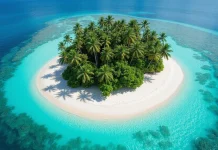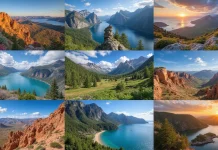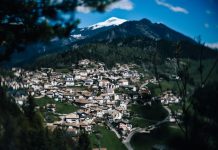The Untamed Wilderness of Gates of the Arctic National Park
Discovering the Heart of Alaska
Gates of the Arctic National Park and Preserve is a place where nature rules in all its untouched glory. Nestled entirely above the Arctic Circle in northern Alaska, this vast park is one of America's most rugged and remote natural reserves. With over 8.4 million acres of pristine wilderness, it offers an unparalleled opportunity to experience the raw beauty of the Arctic. No roads or trails penetrate its boundaries, leaving the land primarily as it has been since time immemorial.
Rich Indigenous History
This pristine region has been home to Indigenous peoples such as the Iñupiat and Athabascan for thousands of years. Their presence in the land is an intrinsic part of its history, and their influence can be seen in place names, traditional campsites, and hunting areas. Understanding this history is crucial for those who wish to fully appreciate the connections between the land and its original inhabitants.
Respecting Traditions
When visiting, it's important to acknowledge and respect these longstanding traditions. Travelers are encouraged to learn about the local cultures, perhaps through exhibits and information provided by the National Park Service or by engaging with local communities, which can enrich your experience of the region.
Planning Your Adventure
Getting There
Reaching Gates of the Arctic is an adventure in itself. Due to its remote location, the park is not accessible by road. Visitors typically fly into Fairbanks, Alaska, and from there, charter a smaller aircraft to villages such as Bettles or Anaktuvuk Pass, which serve as gateways into the park. These flights offer mesmerizing views of the Alaskan wilderness, preparing you for the grandeur of the landscapes you’re about to explore.
Best Time to Visit
Timing your visit to Gates of the Arctic is crucial. Summer months, from June to August, are the most popular time due to milder temperatures and the midnight sun, allowing for extended daylight hours to explore. However, each season offers unique experiences. Spring and fall provide solitude and the chance to witness the vibrant changes in the landscape, while winter visitors can experience the stark beauty of the snow-covered tundra and the mesmerizing northern lights.
Permits and Regulations
Conservation is vital in such a pristine environment, and with that comes certain regulations. While permits are not necessary for entry, visitors should familiarize themselves with Leave No Trace principles to minimize their impact. If planning on fishing or hunting, specific permits and licenses are required, which can be obtained through the Alaska Department of Fish and Game.
The Natural Wonders of Gates of the Arctic
Stunning Landscapes
The park's landscape is nothing short of sublime. It features sprawling tundras, rugged mountains, and crystal-clear rivers that carve their way through inexorable terrain. The Brooks Range runs through the park, a majestic backdrop of jagged peaks that provides a home to diverse flora and fauna.
Notable Geographical Features
Arrigetch Peaks
Among the park's most breathtaking sights are the Arrigetch Peaks, meaning “fingers of the outstretched hand” in the local dialect. These granite spires shoot skyward in the central Brooks Range, offering challenging climbing and hiking opportunities for adventurous travelers.
Walker Lake
For those seeking tranquility, Walker Lake is a serene oasis surrounded by undisturbed wilderness. It provides excellent opportunities for kayaking and is abundant with Arctic char for the fishing enthusiast.
Unique Ecosystems
Within this vast expanse lies a variety of ecosystems that support a rich diversity of life. From the arctic tundra to the boreal forests, this blend of habitats allows for unique interactions between wildlife and plant life, making it a biodiversity hotspot.
Flora and Fauna
Despite its harsh climate, the park is teeming with life. Large mammals such as grizzly bears, moose, and Dall sheep roam freely. Wolves and caribou are also commonly seen, particularly during migration periods. Birdlife is abundant in the summer, with species such as the gyrfalcon and the wandering tundra swan gracing the skies.
Adaptations and Survival
The species that inhabit the park have developed ingenious adaptations to survive the extreme conditions. Plants have short growing seasons and are often low-lying, minimizing their exposure to harsh winds, while animals have evolved with thick coats and remarkable metabolism rates to endure the cold.
Experiencing Gates of the Arctic
Backpacking and Hiking
With no established trails, hiking in the park is raw and exhilarating. Trekkers must rely on map and compass navigation skills to explore its vast wilderness. Areas like the Arrigetch Peaks and the Noatak River are popular among seasoned backpackers seeking solitude and challenge.
Guidelines for Hiking
Being self-sufficient is key in such a remote location. Hikers should be well-prepared with supplies, emergency equipment, and the knowledge necessary for wilderness survival. In addition, sharing your itinerary with a park ranger or loved one is a prudent measure.
Canoeing and Kayaking
The park's waterways are some of its most enchanting features, perfect for those wanting to experience its rugged beauty from a different perspective. Rivers like the Alatna and John offer scenic routes ideal for canoeing and kayaking.
Essential Waterway Information
Water levels can vary significantly depending on the season and weather conditions. It is crucial to check conditions beforehand and be prepared for the possibility of portaging, as well as the potential risks associated with moving swiftly through remote areas.
Winter Activities
Winter transforms Gates of the Arctic into a white wonderland, and for those brave enough to handle the cold, it offers truly unique experiences. Dog sledding and cross-country skiing are exhilarating ways to traverse the landscape, while witnessing the aurora borealis is an unforgettable spectacle.
Winter Preparedness
Ensuring the right gear is essential to safely enjoy winter activities. This includes appropriate clothing for extreme cold, reliable equipment, and emergency supplies. Additionally, understanding the potential hazards like avalanches and thin ice is crucial for safety.
Cultural and Educational Opportunities
Indigenous Culture Tours
Visitors have the chance to engage with Alaska Native communities to deepen their understanding of the region’s history. Local guides often provide tours that highlight traditional practices and offer insights into the lifestyle of those living in the Arctic.
What to Expect
Such tours can vary widely, from storytelling to sharing traditional meals or observing ancient craft techniques. Participating in these tours not only enhances your visit but also supports local communities and preserves their cultural heritage.
Park Ranger Programs
The National Park Service offers various ranger-led programs during the summer. These educational events cover topics ranging from the park’s geological history to its ecological research initiatives. Engaging with rangers can provide invaluable insights into the significance and conservation efforts of the park.
Essential Tips for Visitors
Preparation is Key
Preparation is arguably the most critical aspect of any trip to Gates of the Arctic. Considerations go beyond equipment — mental preparation for the isolation and potential challenges is equally important.
Packing Essentials
Essentials include a high-quality sleeping bag rated for extreme cold, a tent durable against strong winds, and layers of clothing suitable for varying conditions. Don't forget a reliable method for purifying water and enough food to last your journey.
Safety Considerations
Safety cannot be overlooked in such an isolated and demanding environment. Understand the risks posed by wildlife, weather conditions, and physical exhaustion. The ability to read and interpret topographical maps and a good understanding of first aid can be lifesaving.
Emergency Protocols
In case of emergency, having a satellite phone or GPS beacon is strongly recommended. It provides a line of communication should you need assistance. Familiarizing yourself with the nearest emergency services or ranger stations is also advisable.
Leave No Trace Ethics
Preserving the park's environment is paramount. Following Leave No Trace principles ensures that its unspoiled beauty remains for future generations. This includes packing out all waste, camping on durable surfaces, and being mindful of wildlife interactions.
Impact and Preservation
The Importance of Conservation
Gates of the Arctic’s untouched wilderness serves as a crucial ecological benchmark. Its conservation allows researchers to study ecosystems free from human interference and aids in our understanding of climate change impacts in Arctic regions.
Challenges Facing the Park
Despite its remote location, Gates of the Arctic faces challenges from external pressures, such as mining interests and climate change. Protecting this sacred land requires collective effort and awareness to ensure its preservation as a sanctuary for wildlife and an enduring testament to nature’s grandeur.
The beauty and solitude of Gates of the Arctic National Park make it one of America’s most unique destinations. For those willing to venture into its vast wilderness, it offers a profound connection with nature and an adventure like no other.
































